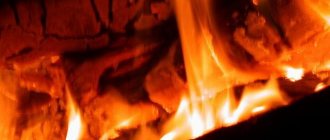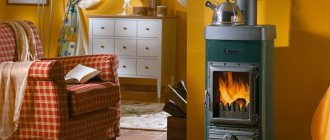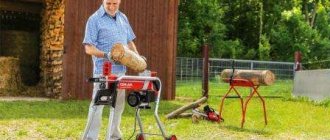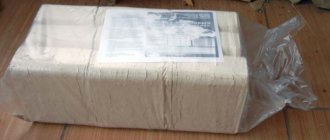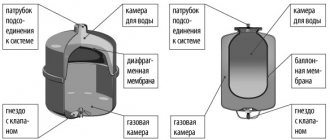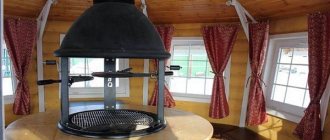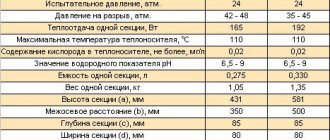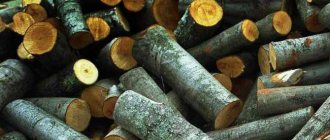Introduction
The purpose of developing a series of interstate standards GOST 33103 is to establish unambiguous and understandable principles for the classification of solid biofuels for the effective development of trade in this type of product, to create mutual understanding between the seller and buyer of solid biofuels, as well as to ensure effective interaction with equipment manufacturers.
- small energy-generating installations usually do not have a very sophisticated system for monitoring and purification of gaseous combustion products; - the management of such installations, as a rule, is not carried out by highly professional specialists; - such installations are often located in residential areas and densely populated areas. Notes
1 Firewood produced in accordance with this standard can be used in stoves, fireplaces, cookers, space heating installations, sauna heating installations meeting the requirements of EN 13229, EN 12815, EN 12809, EN 13240, EN 15250 and EN 15821. as well as in boiler installations that meet the requirements of EN 303-5.
2 When concluding contracts, GOST 33103.1 should be used. Although each part of this series of standards is an independent document, they are all based on the general provisions set out in GOST 33103.1. Therefore, it is recommended to use each individual standard of this series in conjunction with GOST 33103.1.
How to calculate the cubic capacity of chopped firewood
Wood has unique characteristics, since it can be used not only as a building material, but also as a source of energy. Firewood is considered one of the cleanest fuels today.
Many enterprises sell similar goods, which may differ in quality. You can find out how to choose the right firewood on the website https://drovam.rf/drova-kolotye.html.
Calculating stacked firewood
The volume of wood is calculated quite easily if it is lumber that is tightly stacked. But it is impossible to stack the firewood so that there are no gaps between the logs. The calculation of these materials stacked can be divided into several successive steps:
- Initially, you need to calculate how many cubic meters are located on the heap or in the back of the car. To do this, simply multiply the width, height and length of a particular object. You can measure all this with a regular tape measure.
- To get the actual volume of firewood in one pile, the previously obtained value should be multiplied by a factor of 0.7. For example, if you count 10 cubic meters on a folded pile, then taking into account the correction, the volume of wood will be only 7 cubic meters.
Bulk firewood
But firewood is not always neatly stacked in the correct structures. Many people want to know how much volume the bulk heap occupies. This task is more difficult, especially if the firewood is non-standard and differs in log size.
If you have chopped a certain volume at home, then you can calculate it approximately using this method:
- We need to find the volume of the heap. To do this, you need to calculate its approximate form, on the basis of which this value can be obtained. The simplest option is the car body, where firewood was simply poured. The calculation algorithm involves multiplying the height, width and length of the frame.
- The resulting volume in the first step must be converted into storage meters. For this, special coefficients are also used, which depend on the length of the log. For example, if you count 10 cubic meters on a pile, then with a log height of 0.5 m, the number of storage meters will be 100.75 = 7.5 cubic meters.
- To convert the storage measurements obtained in the second step into real volume, you need to multiply the obtained data by a factor of 0.7 (7.50.7 = 5.25 cubic meters).
As you can see, the process of calculating the cubic capacity of chopped firewood is a fairly simple operation that will take you a little time.
Firewood cube
Determining the volume of lumber is quite simple if it is neatly folded: multiply the length by the width and by the height and you’re done. It is more difficult to calculate the volume of chopped firewood or firewood in logs. For this, a unit of measure is used - a “folded” cubic meter, i.e. cubic meter of firewood at intervals.
To convert from stored cubic meters to cubic meters of wood, a conversion factor is used, which depends on the type of wood and the size of the logs. In most cases, a coefficient of 0.7 is used for recalculation.
For example: If they bring you firewood stacked, then we measure the length, height and width of this stack. We multiply the parameters and multiply the resulting volume by a factor of 0.7.
Volume = width * length * height * 0.7 - thus, we get the real volume of firewood.
How to count one cubic meter of firewood stacked in bulk and in nets
How to count one cubic meter of firewood: stacked, in bulk and in grids
Surely every person who has ever ordered firewood has wondered whether the suppliers deceived him? How to determine exactly how much firewood was brought to you? Perhaps you have encountered a villager or an experienced forestry worker who, with one meaningful glance at a pile of firewood, said an almost correct result. In fact, there is nothing difficult in determining the volume of firewood, and this can be done either by eye, with the proper experience, or with high accuracy, using the calculation method. Let's take a closer look at this.
The first thing you need to pay attention to when preparing for the calculation is the type of stacking of firewood. Let's start with the most common - in bulk. In this case, the firewood is thrown into a body or a pile; at first glance, it is quite difficult to estimate the volume, because the logs are not tightly packed
First you need to calculate the total volume of brought firewood. For this purpose, it is necessary to measure the piled firewood. If you have a cone-shaped pile, then we will find out its diameter and height; if the firewood is in the back, we measure the length, height and width; it is better to first level the pile for more accurate calculations. Having calculated the volume, you should convert it into storage meters; for this we use coefficients. Usually the average is 0.7, since this number is used in further calculations, but if an accurate calculation is necessary, the normative document GOST 3243-88 should be used. It indicates exact coefficients that depend on the type of wood, its condition, length and thickness of the logs
In this case, the firewood is thrown into a body or a pile; at first glance, it is quite difficult to estimate the volume, because the logs are not packed tightly. First you need to calculate the total volume of brought firewood. For this purpose, it is necessary to measure the piled firewood. If you have a cone-shaped pile, then we will find out its diameter and height; if the firewood is in the back, we measure the length, height and width; it is better to first level the pile for more accurate calculations. Having calculated the volume, you should convert it into storage meters; for this we use coefficients. Usually the average is 0.7, since this number is used in further calculations, but if an accurate calculation is necessary, the normative document GOST 3243-88 should be used. It indicates exact coefficients that depend on the type of wood, its condition, length and thickness of the logs.
Now we know how many folded cubic meters were brought to us, but we ordered cubic meters, which means solid wood without gaps. On average, it is believed that one folded meter is equal to 0.7 cubic meters of solid wood. It is this coefficient that is used in most cases, although for accurate calculations, you should return to the conversion table set out in GOST 3243-88.
Another popular method of delivering firewood is in grids or stacked in rows. In this case, determining the number of cubic meters brought is quite easy. We don’t have to convert the bulk volume to the folded volume; the only thing that needs to be done is to measure the woodpile, calculate the volume, and then make calculations using the coefficient already known to you.
As you can see, there is nothing complicated in the calculations. To accurately determine the number of cubic meters, you just need to find out the volume of brought firewood, convert it into storage meters, and then, using the coefficient, find out the number of cubic meters.
And if you are interested in the weight of firewood, then after reading our article, you will know the many parameters that need to be taken into account when calculating the weight of wood: How much does firewood weigh?
We work without cheating! We always deliver the exact amount of firewood you ordered!
It’s very easy to order firewood in Moscow and the Moscow region!
A cube of firewood calculated according to science
When the logger brings his timber to the sawmill, its quantity is taken according to special tables. The table calculates the so-called useful output volume. After all, every tree is thicker at the base and thinner towards the top.
Often the customer begins to calculate the amount of firewood in the machine, multiplying it by the coefficients from the tables.
This is a scientific and probably correct approach. only a cube of wood at a sawmill costs 2,500 rubles, and hundreds of kilometers in the Moscow region costs 1,800.
Why are you bringing firewood here to the capital when it’s so expensive there?
Such questions are asked often. The thing is, birch is an excellent tree for firewood. It burns hot and doesn't crackle. But there are no boards made from it; it is only suitable for pallets.
So forestry companies transport aspen and fir trees to sawmills, and birch trees for firewood to Moscow.
PREMIUM BIRCH FIREWOOD
Chamber-dried birch firewood has a moisture content of about 15% and is ideal for use as fuel for a fireplace, bathhouse or barbecue.
Birch firewood of this type belongs to the premium firewood category. They are somewhat more expensive (you can find out the cost here) than other types of firewood, due to the fact that each log is pre-washed under high pressure and dried in a special chamber. Humidity of 15% allows you to quickly ignite a fire, is guaranteed to reduce the level of soot and deposits in pipes, and ensures a high and stable temperature during combustion.
Birch firewood, hand-selected, in addition to the purely utilitarian purpose of heating, can and does act in many country houses as interior decoration. Birch firewood (logs) create a feeling of comfort and antiquity
We buy firewood
Which firewood is more profitable to buy: split or round? loose or stacked? We suggest you look into this issue and save a lot, especially if firewood serves as the main fuel for heating your home.
Firewood is usually sold by the cubic meter. But, oddly enough, the cube is different from the cube. And this difference is noticeable. Let's start with the fact that the cubic meter of firewood that we buy is far from the true cubic meter. You have to pay not only for wood, but also for air in the literal sense of the word, because it is impossible to lay firewood without creating voids between them. Therefore, we purchase the so-called folded cubic meter, if the firewood is delivered folded, or bulk, if the firewood is piled in bulk.
To understand how many folded cubic meters will come out of the bulk ones, you need to multiply the volume of firewood by 0.8. The indicator will, of course, be approximate, because a lot depends on the size of the logs, and it is impossible to calculate how densely the firewood will settle. And yet, the mass of firewood from a bulk cubic meter will be approximately 20% less.
But which firewood is more profitable to buy - split or round?
At first glance, the answer is obvious: chopped firewood is smaller, so it is stacked more tightly - and there will be more stacked cubic meters. But here lies the catch. Conduct an experiment: chop a few logs and the volume of the woodpile will increase. This is noticeable even with the most careful stacking of firewood. A natural question arises: will the seller waste time and resources on such dense loading? Never! This means that the losses will be greater.
To fix the difference between a cube of chopped and unchopped firewood, GOST introduced full wood coefficients, which establish the relationship between the volume of firewood and the full cube of wood. This means that it is enough to carry out simple calculations. It is necessary to multiply the volume of firewood by the full wood coefficient. This indicator depends on the length, size and type of logs or logs. To determine the exact value of the coefficient, we suggest using the following table.
The table shows that from one cubic meter of average hardwood logs 0.25 m long, 0.8 m3 of real wood comes out. From split logs with the same indicators you will get 0.76 m3. The difference from each cubic meter is 0.04 m3.
By the way!
GOST coefficients are valid for the most dense stacking of chopped firewood. If the wood in the brought woodpile is stacked in a well, supposedly for better drying, then you are being led by the nose - ask for a new measurement of the cubic capacity of the firewood.
When talking about the benefits of certain firewood, one cannot ignore their cost. Pricing principles among sellers may differ, but there are still some average indicators. More expensive than the others are stacked chopped firewood. Their average price is 1,500 rubles. for 1 m3. Chopping firewood in bulk will cost about 100 rubles less. The stacked logs will cost the same. A cubic meter of logs in bulk will cost about 1,300 rubles. for 1 m 3.
Which firewood to choose
The smallest amount of firewood will be obtained when ordering chopped firewood in bulk. For clarity, let’s calculate the value of the folded measure from the bulk one, and then calculate the true volume of firewood, taking the already familiar indicator of 0.76 as the full-wood ratio.
So, we get: 1 m 3 x 0.8 * 0.76 = 0.6 m 3
That is, when ordering a bulk cube of chopped firewood, in its pure form we get a little more than half a cube of wood for about 1,400 rubles. A full-wood cube in this case will cost 2,333 rubles.
Buying a bulk cubic meter of logs, following the same calculations and using the full wood coefficient for unsplit firewood, we get 0.64 cubic meters of real wood for 1,300 rubles. Here the cost of a full-wood cube is 2,031 rubles.
From a purchased cube of stacked chopped firewood, approximately 0.76 m3 will come out, costing 1,500 rubles. Total: 1,973 rub. for a full wood measure.
A similar volume of stacked logs (unsplit firewood) will yield 0.8 m3 of real wood. At a cost of approximately 1,400 rubles. a full-wood cube will cost 1,750 rubles.
You can save money by chopping your own wood. If you use hired labor, you will have to add the cost of the work, but you need to add it not to the final price of a full-wood cube, but to the cost of the purchased cubic meter. By the way, after chopping firewood, you will be left with a nice bonus - wood chips, which are sold for 100 rubles. per bag.
Cube of chopped wood (dies)
There is undoubtedly more chopped firewood in a cube, but it also costs more. Is it worth buying split logs?
Let us again depict in the figure a cube of firewood laid in dies. It will look something like this.
I specifically showed the gaps between the dies in the picture. After all, not one worker at the enterprise will stack chopped firewood as carefully and tightly as you yourself. In the figure we see that the dies lie more densely. And although all manufacturers ask more money for such firewood, I think this is justified.
Bulk instead of real ones.
Let me draw your attention once again to the fact that we are talking about dry firewood with a moisture content of no more than 20%. The calorific value of 1 kg of such firewood will be at least 4 kW
But if their humidity turns out to be increased, which most often happens, then their calorific value drops sharply. For example, 50% humidity will reduce the heating value of firewood by half. So the main disadvantage of wet firewood is not that it does not burn well, but that it produces little heat. And finally, about one more trick that firewood sellers most often resort to. Cubic meters are real, folded and bulk. You pay money for a real cubic meter, but, alas, a rare seller uses real cubic meters when calculating the volume. In the best case, you will get folded cubic meters, in the worst - bulk. So not only trust, but also verify!
What is a cubic meter
As the name implies, a cubic meter or cubic meter (m3) is the volume of a cube whose sides measure a meter. This value is usually used to measure gas, water, snow, sand and other bulk and liquid materials.
However, this value is only suitable for measuring one whole piece of wood, for example, pine: after all, if you fold a cube of individual firewood and boards, there will still be a distance between them, albeit a few millimeters.
Consequently, when purchasing firewood, boards and other “non-pillar” pieces, cubic meters are not suitable: you would have to measure each block from all sides and try to fit them within the given parameters. This is too long and can still lead to errors.
1 firewood storage meter, how much is it, how is firewood measured?
This information will help you avoid wasting money - it will be more difficult for unscrupulous sellers to deceive you.
It's no secret that wood contains moisture, and in freshly cut wood it is about 40-70 percent and such firewood can be called damp.
When burning raw wood, part of the energy will be spent on evaporating the moisture present in it, which means that more reserves of raw fuel will have to be made, either in advance and allowed to dry
When purchasing, you should pay special attention to this. They can sell raw firewood under the guise of dry firewood. How to determine how much firewood was brought to you? – This is one of the most important questions when purchasing
How to determine how much firewood was brought to you? – This is one of the most important questions when purchasing.
First, familiarize yourself with the methods of stacking firewood, after which it will become clear why this issue is so important.
Firewood in bulk
- this is when they threw it into the car at random. It looks like it’s a lot, but when you carefully put it in a woodpile, it turns out it’s not enough (sometimes significantly). It turns out this way because of the free space between the logs, or they can also be specially folded in the form of a hut, which increases the voids.
By weight, the density of bulk firewood will be around 300-400 kg, depending on the wood, a little more a little less.
Firewood stacking (stacking) is when logs are neatly stacked log by log.
As you can see from the pictures, neatly stacked firewood has much less voids, so the likelihood that you will be deceived (at least in terms of volume) is much lower.
When purchasing, it will be quite easy to control the volume visually. And if you wish, it is much easier to calculate how much firewood was brought to you.
Methods for calculating the volume of firewood
Firewood sellers count their goods in dense meters (without voids), and sell them stacked in a woodpile (in stack meters). But, since firewood is usually transported in bulk, the volume will be completely different. It can be calculated based either on the volume of the body or on the volume of the resulting heap.
A heap is, roughly speaking, a cone
The volume of a cone, according to the geometry course, is found by the formula:
V=1/3*PI number*radius square*height
So, if they brought it, poured it out and found a cone with a height of 1.5 m and a radius (we remember, this is half the diameter) of 2 m, then the “bulk volume” will be equal to 6.28 cubic meters.
To get the volume of firewood stacked in a woodpile, you need to multiply the “bulk volume” by 0.82.
Our cone turns into folding meters:
It is converted to a dense measure by multiplying by an average calculated coefficient of 0.6-0.8 (depending on the type and quality of wood, length and shape of firewood). See GOST 3243-88. Firewood.
In practice, the average K = 0.7 is used.
Thus, our cone turns into a dense cube: 5.15 * 0.7 = 3.6 cubic meters.
Or, for example, GAZ-53 has a body volume of 4.8 cubic meters.
This means that the volume of firewood “in bulk” is converted into folded, and then into dense: 4.8 * 0.82 * 0.7 = 2.76 cubic meters.
If the firewood is stacked, the volume of firewood is easy to calculate
The formula for the volume of a parallelepiped is known to everyone.
If loading occurs in the wrong shape, then the reference point is to the volume of the body or to the cone when unloading.
Remember, there is GOST 3243-88, there is a coefficient for each type of firewood. Although in practice the calculations are made approximately approximately.
On a note
| Truck type | In bulk | Styling |
| GAZ-53 “Lawn” ZIL dump truck | 3,95 | 2,76 |
| Gazelle 3302 | 3,3 | 2,3 |
| KAMAZ | 7 | 4,9 |
Sometimes the firewood is loaded with a heap, sometimes without.
You can never see how they are laid on the bottom.
It is better to count the already unloaded “cone”.
How do people cheat when selling firewood?
When buying in bulk, they can arrange something like a hut, thereby reducing the actual volume; instead of 4 cubes, they will sell 3.
They will sell dried firewood under the guise of dry firewood; to do this, the raw wood will be added to the center so that it will not be visible even after unloading (if it is piled up, first the upper part will cover the raw wood, and then the lower part will cover it).
You can also unload it in different ways, either by pouring it in a heap, or by driving it evenly - visually it will immediately be visible where there is less firewood.
via The Washington Post
Calculation and weight
To calculate the weight of a stack, you need to multiply the number of folding meters by a coefficient, and then check the coincidence of the number using tables that are easy to find on the Internet.
They indicate the approximate weight of 1 cubic meter of different breeds. For example, fresh oak weighs 1000 kg, but with natural humidity of 15% it weighs only 710 kg.
4 stackers of dry split oak logs with a length of 0.25 meters and a moisture content of 15% were purchased. You need to check their weight:
- The coefficient of such firewood is 0.76: 0.76*4 = 3.04 cubic meters. meters;
- 3.04 * 710 kg = 2158.4 kg - this is approximately how much the purchased firewood should weigh. If the difference deviates excessively in any direction, it means the seller is trying to deceive.
Please note: when buying a tree, it is important to know not only its volume, but also its weight: if stored improperly, the tree can swell and become much heavier than it was, and the buyer will still have to pay for this.
If the tree was brought in the back of a car, for example, a Gazelle or a dump truck, not in a woodpile, but thrown somehow, it is necessary to multiply the volume of the body by 0.8 with a log length of 0.25 meters and by 0.75 with a length of 0, 5 meters. These are the average values of air occupied for such installation.
Amount of firewood for winter
One of the paradoxes of the universe: the more ordinary and familiar an object of natural origin, the more complex its mathematical description. In order to calculate the volume of a Galaxy or star, it is enough to remember a school geometry course. If someone really needs to know the exact volume of a log, it is impossible to do without differential calculus methods. Because of an astronomer's mistake, the average person is neither hot nor cold; But if the fuel reserves for the winter are incorrectly calculated, the cold in the house is ensured.
Everything seems simple: we multiply the duration of the heating season in days by the area of the house and the average daily consumption of firewood. Do not believe this simplicity, it is deceptive and requires many clarifications. In fact, it is also necessary to take into account the height of the ceiling, i.e. not area, but volume. The most interesting thing begins when it comes to the average daily consumption of firewood. This value depends on the calorie content of the fuel, the efficiency of the furnace, climatic conditions, heat loss and many other factors, including the radius of curvature of the master’s hands. The last parameter is an irrational value that can reduce heating efficiency to zero. If you set out to derive a universal formula for accurate calculations, there will be enough material for more than a dozen dissertations. It is much faster to make inquiries from neighbors or former owners of the house.
If you are planning to install a solid fuel boiler, it is easier to calculate its “appetite” - the main technical characteristics are known. The easiest way to get an approximate figure is to use formulas or online calculators posted on specialized websites.
Let's try to calculate.
As a standard, let's take a house with a total area of 150 square meters. m and insulated according to SNiP. In the coldest time, about 100 W/m² will be needed to heat the room. Let's take the average energy consumption as 50 W/m². The heating season lasts 7 months (214 days). With continuous heating we get:
150 m²•50 W/m²•24 h•214 days = 38.52 MWh, which approximately corresponds to 33 Gcal.
The specific lower heat of combustion of absolutely dry firewood is 4440 kcal/kg. During natural drying for about two years, the residual moisture content of the wood is 20%, the specific heat of combustion is 3400 kcal/kg. Let us take the efficiency of a solid fuel boiler to be 70%.
We calculate the required amount of firewood: 33000kcal•1000/3400kcal/kg/ 0.7/0.730 kg/m³≈19 m³, where 0.730 kg/m³ is the density of oak wood. In terms of maple or birch, the required value is 21.3 m³, and for pine – 26.4 m³. In practice, you may need less or more firewood, depending on the state of the house’s thermal insulation and weather conditions.
All-knowing statistics claim that to heat a small insulated log house in central Russia, 4-6 cubic meters of firewood per season is sufficient. The most economically justified supply of firewood is for two or three seasons: current + 1-2 next. In this case, you will probably have enough fuel even for the longest cold period. Another argument: firewood, like good alcohol, only gets better over time.
“God have mercy, what kind of firewood? We are civilized people, we have gas!” – this position is fundamentally wrong. Firstly, because we have the good fortune to live in the most amazing country in the world. Here, from time immemorial, two scenarios have been observed: the unlikely and the worst. Secondly, the civilized world is returning to proven and, most importantly, renewable energy sources. Firewood, straw and peat are all the same as hundreds of years ago, adjusted for modern technology.
Having a solid fuel boiler and at least a year’s supply of firewood in a gasified house is not a whim, but a completely reasonable solution. Optimism is good, but optimism backed by strategic reserves is twice as good.
You can also use our online calculator to calculate the amount of chopped wood for heating a country house, cottage or bathhouse.
Number of firewood in terms of load capacity
The old type tractor cart is capable of lifting 4 tons of cargo. According to the villagers, they transport 6 tons.
Knowing the average weight of various types of wood with natural moisture, you can calculate how many cubes are in a tractor trailer. Provided it is overloaded.
With overload, the tractor cart includes:
- 10 cubes of birch wood;
- 8 cubic meters of oak;
- 11.2 cubic meters of aspen dies.
The calculation is made on the condition that the firewood is chopped and stacked in the body.
The new tractor cart marked 2PTS-4.5 has a load capacity of 4.5 tons. We do not have data on how much this model can be overloaded. But since the design has not changed radically, we will assume that it will withstand an overload of 2 tons.
The carrying capacity of the 2PTS-4.5 cart is close to the previous model. This trailer will accommodate 0.8 cubic meters more firewood.
- Birch firewood can fit 10.8 m3;
- Split alder fits 13.8 cubic meters;
- Oak trees will fit 8.8 cubic meters;
- There will be 12 cubic meters of aspen firewood.
https://www.drovavoz.ru/drov-v-telege.html - link
How many cubic meters of firewood are there in the Lawn?
Determining the volume of firewood neatly stacked for storage is quite simple. It is much more difficult to find out how many cubic meters are in the car that was brought to you. Let's consider, for example, how many cubic meters of firewood are in a GAZ 53.
First, we must find out the full volume of the car body. The standard Lawn has a body volume of approximately 4.8 cubic meters. If you see that the firewood is loaded without a slide, then its volume clearly cannot be higher.
There are body modifications with silo (extended) sides, whose volume is increased by 1.5 - 2 times.
In addition to the volume of the body, the laying method influences how many cubes of firewood are in the lawn. More precisely, the presence of stacking: if the firewood is neatly stacked, then it occupies almost the entire volume of the body, but if it is dumped in bulk, then there is a lot of free space between them. There is a special coefficient for converting the bulk volume into the volume of folded cubic meters. The coefficient depends on the length of the log. For example, for a log of a quarter meter the correction factor is 0.8, and for a log of 3 quarters of a meter it is already 0.73.
This means that 4 cubic meters of firewood with an average length of 25 cm, brought in bulk, will turn into 3.2 cubic meters after stacking.
Is it possible to fit 6 cubic meters of firewood in a GAZ 53?
As we have already said, if the car has extended sides or if you load the body with a significant slide, then it is possible. This becomes more likely if the firewood is loaded by stacking rather than in bulk. In the latter case, even in an 8-cube body there may be 2-3 cubic meters of firewood.
Let's consider how many cubic meters of firewood are in the GAZ 66. The volume of the body of this car may vary depending on the type, but, on average, it is 3 - 4 cubic meters, without extended sides. This is also the maximum volume of transported firewood, taking into account normal stacking along the sides.
So, to estimate the volume of firewood brought, you need to know the volume of the body and the method of stacking the firewood. The situation becomes somewhat more complicated when loading “heaped”, but its volume can also be calculated by dividing the firewood into 2 conventional geometric shapes:
- Body parallelepiped along the sides;
- Separate slide. For ease of counting, you can even level the slide, making it flatter.
By adding the volume of both figures (obtained by multiplying the length, height and width) we get the approximate volume of firewood.
https://samanka.ru/skolko-kubov-drov-v-gaz-53.html — link
Body dimensions of GAZ 53 - 3740*2170*680 mm. Multiplying these indicators, we get a volume of 5.2 cubic meters. This is the volume of the factory body along the edges of the sides. Load capacity - 4 tons. Of course, the cubic capacity of the body can be easily increased by making stripes. Craftsmen increase the cubic capacity by 1.5, 2, or even 2.2 times. Usually, stripes of the same height are made on factory sides. Then the body volume will be about 11 cubic meters.
How to count a cube of firewood
To simplify the recalculation process and reduce the possibility of deception, another term was created - foldometer.
It is easiest to imagine it in the form of a woodpile measuring 1 m x 1 m x 1 m, into which the logs were stacked, fitting them as closely as possible to each other. There is still some distance between them - small, but significant when purchasing a large amount of firewood.
To convert the scadometer to a cubic meter, it is necessary to calculate the dimensions of the stack (length, height and width) and multiply by the special coefficient indicated in the table below. This will help to get the volume of firewood close to the truth.
The value of the coefficient can be found in special tables and in the photo: they depend on the type of wood, the length of the log and its volume.
For deciduous trees
| Log length | Round thin | Round medium | Stabbed | Mixture |
| 0.25 meters | 0,75 | 0,8 | 0,76 | 0,76 |
| 0.5 meters | 0,69 | 0,75 | 0,71 | 0,71 |
| 0.75 meters | 0,65 | 0,72 | 0,69 | 0,69 |
| 1 meter | 0,63 | 0,7 | 0,68 | 0,68 |
For coniferous trees
| Log length | Round thin | Round medium | Stabbed | Mixture |
| 0.25 meters | 0,79 | 0,81 | 0,77 | 0,77 |
| 0.5 meters | 0,74 | 0,76 | 0,73 | 0,73 |
| 0.75 meters | 0,71 | 0,74 | 0,71 | 0,72 |
| 1 meter | 0,69 | 0,72 | 0,70 | 0,7 |
In other words, the shorter the logs, the more space they can take up in the package, while round firewood takes up more volume than split firewood.
The easiest way to see the meaning of a warehouse meter is with an example:
A stack of thin birch logs 0.75 meters long was purchased. The dimensions of the stack itself were 1.5 meters * 3 meters * 2.5 meters. It is necessary to calculate the total volume of firewood occupied using a calculator:
- It is necessary to calculate the volume of the stack itself by multiplying its sides: 1.5 * 3 * 2.5 = 11.25 cubic meters. meters;
- Then you need to determine the coefficient of the firewood itself: for birch it is 0.65;
- Both numbers are multiplied again: 11.25 * 0.65 = 7.3125 - this is the specific gravity.
The total difference was almost 4 cubic meters. meters. If there were no scadometer value, the buyer would have to significantly overpay for the purchase.
Capacity 131
The next car is called ZIL 131. It is an all-terrain vehicle with all-wheel drive. It was intended for the army.
https://www.drovavoz.ru/drov-v-zile.html - link
| "Gazelle" | |
| Length: 2.8-3.2 m (extended options up to 4.5 m exist) Width: 1.8 - 1.9 m Height: 1.7 - 2 m Volume: 9-11 m3 Load capacity: 1.5 - 1.7 tons | Based on their main consumer qualities (tonnage, volume, overall dimensions), various models of domestic and imported trucks can be classified as Gazelle class vehicles. The cargo compartments of these vehicles may differ slightly in overall dimensions and, accordingly, volumes. Cars of this class are actively used on intracity and intercity routes of short and medium range (500-700 km). Technical characteristics allow us to guarantee a fairly high average speed (up to 100 km/h) and the cabin layout provides space for one or two passengers (forwarders). The tilt version of the cargo compartment suggests the ability to open the cargo compartment and get an open cargo compartment. The car can be equipped with fastening belts and other additional equipment (elevator, hard sides). |
| "ZIL-Bychok" | |
| Length: 3.7 m Width: 2.1 m Height: 2.2 m Volume: 17 m3 Load capacity: 3.5 tons | Based on their main consumer qualities (tonnage, volume, overall dimensions), various models of domestic and imported trucks can be classified as ZIL-Bychok class vehicles. The cargo compartments of these vehicles may differ slightly in overall dimensions and, accordingly, volumes. Cars of this class are actively used on intracity and intercity routes of short and medium range (500-700 km). Technical characteristics allow us to guarantee a fairly high average speed (up to 80 km/h); a small axle load allows this vehicle to drive unhindered in areas with restrictions on the entry of freight vehicles |
| "ZIL" | |
| Length: 3.5 - 4 m Width: 2-2.3 m Height: 2.45 m Volume: 14-21 m3 Load capacity: 5 tons | Based on their main consumer qualities (tonnage, volume, overall dimensions), various models of domestic and imported trucks can be classified as ZIL class vehicles. The cargo compartments of these vehicles may differ slightly in overall dimensions and, accordingly, volumes. Cars of this class are actively used on intracity and intercity routes of short and medium range (500-700 km). Often used for transporting personal belongings and moving. |
How many cubes are in the storage meter are important parameters in the calculation. Press!
All over the world there are uniform measurement systems: kilograms for determining weight, meters for the size of things, etc.
When harvesting and transporting firewood and forests, cubic meter and storage meter measurements are usually used - there is some difference between these values, which not everyone knows about.
What is a cubic meter
This value is usually used to measure gas, water, snow, sand and other bulk and liquid materials.
However, this value is only suitable for measuring one whole piece of wood, for example, pine: after all, if you fold a cube of individual firewood and boards, there will still be a distance between them, albeit a few millimeters.
It is important to know: in construction, the cubic capacity of wood is also measured in cubic meters: this is necessary when transporting and storing building materials.
Consequently, when purchasing firewood, boards and other “non-pillar” pieces, cubic meters are not suitable: you would have to measure each block from all sides and try to fit them within the given parameters. This is too long and can still lead to errors.
How to count a cube of firewood
It is easiest to imagine it in the form of a woodpile measuring 1 m x 1 m x 1 m, into which the logs were stacked, fitting them as closely as possible to each other. There is still some distance between them - small, but significant when purchasing a large amount of firewood.
To convert the scadometer to a cubic meter, it is necessary to calculate the dimensions of the stack (length, height and width) and multiply by the special coefficient indicated in the table below. This will help to get the volume of firewood close to the truth.
The value of the coefficient can be found in special tables and in the photo: they depend on the type of wood, the length of the log and its volume.
For deciduous trees
For coniferous trees
In other words, the shorter the logs, the more space they can take up in the package, while round firewood takes up more volume than split firewood.
The easiest way to see the meaning of a warehouse meter is with an example:
A stack of thin birch logs 0.75 meters long was purchased. The dimensions of the stack itself were 1.5 meters * 3 meters * 2.5 meters. It is necessary to calculate the total volume of firewood occupied using a calculator:
- It is necessary to calculate the volume of the stack itself by multiplying its sides: 1.5 * 3 * 2.5 = 11.25 cubic meters. meters;
- Then you need to determine the coefficient of the firewood itself: for birch it is 0.65;
- Both numbers are multiplied again: 11.25 * 0.65 = 7.3125 - this is the specific gravity.
The total difference was almost 4 cubic meters. meters. If there were no scadometer value, the buyer would have to significantly overpay for the purchase.
Calculation and weight
They indicate the approximate weight of 1 cubic meter of different breeds. For example, fresh oak weighs 1000 kg, but with natural humidity of 15% it weighs only 710 kg.
Example:
4 stackers of dry split oak logs with a length of 0.25 meters and a moisture content of 15% were purchased. You need to check their weight:
- The coefficient of such firewood is 0.76: 0.76*4 = 3.04 cubic meters. meters;
- 3.04 * 710 kg = 2158.4 kg - this is approximately how much the purchased firewood should weigh. If the difference deviates excessively in any direction, it means the seller is trying to deceive.
If the tree was brought in the back of a car, for example, a Gazelle or a dump truck, not in a woodpile, but thrown somehow, it is necessary to multiply the volume of the body by 0.8 with a log length of 0.25 meters and by 0.75 with a length of 0, 5 meters. These are the average values of air occupied for such installation.
Take note: the storage meter is a useful value for the buyer, allowing you to avoid paying for “air”. When purchasing wood by cubic meters, it is worth remembering how to correctly calculate the total, otherwise the amount will look somewhat inflated.
How to calculate cubic capacity, see the calculation example in the following video:
A few words about terms
A banal desire to find out how much firewood weighs actually turns into an interesting excursion into botany, geography, geometry and physics. Moreover, no one guarantees the accuracy of the calculation; the data will “walk” every day. Perhaps this is why sellers do not ask “how much to weigh in grams”, but suggest using the volume of wood instead of mass.
How much can a cube of firewood weigh and how to calculate it correctly? More details about everything below:
As you know from a physics course, mass (how much it weighs in kilograms/centners/tons) and weight (the force with which it is attracted to the Earth, measured in newtons) are different concepts, although in everyday life they have long become synonymous.
When talking about the weight of firewood, three points can be kept in mind:
- weight - exactly how many kilograms of wood fit into a cube in order to estimate the real cost of the product and whether the seller was deceived;
- the weight of a cube of stacked firewood - with what force the forest will press on the base of the machine, firewood stand, rack shelf, garage tiles, plank floor of the veranda, etc., when it is necessary to determine whether the building or structure will withstand such a load;
- the weight of the wood - how dense the structure is and how long it will take to dry, burn well and give off heat.
Most often, ordinary people talk about the weight of firewood, meaning mass. They are interested in how much birch chopped firewood weighs in kilograms. Such a substitution of concepts helps to avoid confusion in the dialogue between the seller and the buyer.
What you need to know to calculate
Before calculating fuel for the entire season, you need to clarify a number of points, since firewood consumption depends on several factors. Here is a list of questions that require answers:
- How much heat is needed to heat a country house in your area of residence?
- What type of wood is planned to be burned?
- What is the moisture content of this wood? Is it freshly cut, semi-dry, or has it been around for a year or two?
- What is the efficiency (COP) of your heating unit? Indicated in the passport for a solid fuel boiler or stove.
Thermal energy consumption for heating a private home is determined by calculations performed by specialists or by an aggregated calculation method. For most homeowners, the second option is more acceptable, since you have to pay for the first. Its essence is this: on the coldest days, 10 kW/h of heat is allocated to heat 100 m² of building area located in a temperate climate zone. Taking into account the temperature change during the heating period, the average consumption during the season will be 5 kW/h.
Different types of wood release different amounts of thermal energy when burned, which is why it is important to know this in advance. The table below shows the calorific value of firewood of different types, referred to a measure of volume - 1 m³:
As can be seen from the table, the moisture content of wood fuel also affects the calorific value. The drier the wood, the more energy can be obtained per unit volume. This is understandable: when raw wood burns, part of the heat is spent on evaporating moisture and is not used to heat the house.
The efficiency indicator (EI) makes it clear what part of the thermal energy from burning fuel the boiler is able to direct into the heating system, throwing the rest into the chimney. This value is specified in the technical data sheet of each heat generator. For those who have not yet purchased a wood-burning heat source, here are the efficiency indicators for various heaters:
- when burning in a classic solid fuel boiler, 70 to 75% of the heat is used;
- the same, in a pyrolysis boiler - 80%;
- Russian brick or bell-type oven – 65%;
- steel or cast iron stove – no more than 55%.
